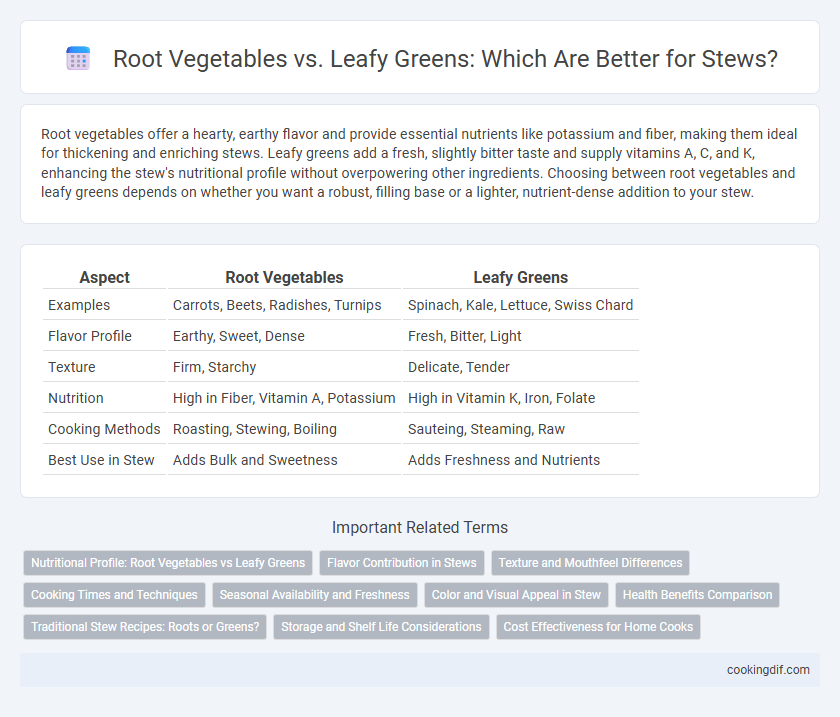Root vegetables offer a hearty, earthy flavor and provide essential nutrients like potassium and fiber, making them ideal for thickening and enriching stews. Leafy greens add a fresh, slightly bitter taste and supply vitamins A, C, and K, enhancing the stew's nutritional profile without overpowering other ingredients. Choosing between root vegetables and leafy greens depends on whether you want a robust, filling base or a lighter, nutrient-dense addition to your stew.
Table of Comparison
| Aspect | Root Vegetables | Leafy Greens |
|---|---|---|
| Examples | Carrots, Beets, Radishes, Turnips | Spinach, Kale, Lettuce, Swiss Chard |
| Flavor Profile | Earthy, Sweet, Dense | Fresh, Bitter, Light |
| Texture | Firm, Starchy | Delicate, Tender |
| Nutrition | High in Fiber, Vitamin A, Potassium | High in Vitamin K, Iron, Folate |
| Cooking Methods | Roasting, Stewing, Boiling | Sauteing, Steaming, Raw |
| Best Use in Stew | Adds Bulk and Sweetness | Adds Freshness and Nutrients |
Nutritional Profile: Root Vegetables vs Leafy Greens
Root vegetables like carrots, potatoes, and beets provide a rich source of complex carbohydrates, dietary fiber, and essential minerals such as potassium and magnesium, supporting sustained energy and electrolyte balance in a stew. Leafy greens, including spinach, kale, and Swiss chard, offer higher concentrations of vitamins A, C, and K, along with antioxidants like lutein and beta-carotene, which contribute to immune function and anti-inflammatory benefits. Incorporating both root vegetables and leafy greens optimizes the stew's nutritional profile by balancing energy-providing macronutrients with potent micronutrients and phytochemicals.
Flavor Contribution in Stews
Root vegetables such as carrots, parsnips, and turnips contribute a natural sweetness and earthy depth to stews, enhancing the overall rich and hearty flavor profile. Leafy greens like kale, spinach, and Swiss chard add a slightly bitter and fresh note, balancing the stew's richness while contributing subtle vegetal undertones. Combining both provides a complex flavor dimension, where root vegetables offer robust body and leafy greens impart lightness and brightness.
Texture and Mouthfeel Differences
Root vegetables like carrots, parsnips, and potatoes provide a hearty, dense texture that softens generously during stewing, offering a satisfying bite and creamy mouthfeel. Leafy greens such as kale, spinach, and Swiss chard deliver a tender, delicate texture that wilts quickly, adding a light, slightly fibrous contrast without overpowering the stew's thickness. Combining root vegetables and leafy greens balances the stew's texture by blending substantial, melt-in-your-mouth components with subtle, silky, and leafy notes.
Cooking Times and Techniques
Root vegetables like carrots and potatoes require longer cooking times, often benefiting from slow simmering to achieve tenderness and enhance natural sweetness. Leafy greens such as spinach and kale cook quickly, typically added in the final minutes of stew preparation to preserve their texture and nutrients. Using appropriate techniques ensures balanced flavors and optimal texture in stews, with root vegetables providing hearty substance and leafy greens contributing freshness.
Seasonal Availability and Freshness
Root vegetables like carrots, potatoes, and parsnips thrive in cooler seasons, offering robust flavors and long shelf life, ideal for hearty stews during fall and winter. Leafy greens such as spinach, kale, and Swiss chard peak in spring and early summer, providing fresh, tender textures that brighten lighter stew recipes. Choosing vegetables based on seasonal availability ensures maximum freshness and nutrient density, enhancing both taste and nutritional value in your stew.
Color and Visual Appeal in Stew
Root vegetables like carrots, parsnips, and beets add vibrant orange, creamy white, and deep red hues to stew, enhancing its color depth and visual appeal. Leafy greens such as kale, spinach, and Swiss chard introduce rich green tones and delicate textures that contrast with the heartier root vegetables, creating a visually balanced and appetizing presentation. Combining both types offers a harmonious palette of warm and fresh colors, elevating the stew's overall aesthetic and making it more enticing to the eye.
Health Benefits Comparison
Root vegetables like carrots and sweet potatoes offer high levels of fiber, potassium, and antioxidants that support heart health and boost immune function. Leafy greens such as spinach and kale provide essential vitamins A, C, and K, along with calcium and iron, which promote bone health and improve blood circulation. Combining root vegetables and leafy greens in stew maximizes nutrient intake, enhancing overall health benefits.
Traditional Stew Recipes: Roots or Greens?
Root vegetables such as carrots, potatoes, and parsnips provide a hearty texture and natural sweetness that enrich traditional stew recipes with depth and warmth. Leafy greens like kale, spinach, and chard offer a vibrant color and a slight bitterness that balances the richness of meat-based broths. Choosing roots enhances the stew's body and comfort, while greens contribute fresh, nutrient-dense layers, making both essential depending on desired flavor profiles.
Storage and Shelf Life Considerations
Root vegetables like carrots and potatoes have a longer shelf life and can be stored for weeks in a cool, dark place without significant loss of texture or flavor. Leafy greens such as spinach and kale require refrigeration and typically last only a few days before wilting or nutrient degradation occurs. Choosing root vegetables for stew ensures greater storage flexibility and reduces waste compared to the shorter-term freshness demands of leafy greens.
Cost Effectiveness for Home Cooks
Root vegetables like carrots, potatoes, and parsnips provide a cost-effective base for stews due to their long shelf life and affordability, allowing home cooks to maximize flavor without frequent grocery trips. Leafy greens such as kale and spinach, while nutrient-dense, tend to be pricier and spoil faster, making them less economical for large-batch or long-cooking stews. Prioritizing root vegetables ensures budget-friendly meals with sustained freshness, ideal for home cooks seeking value and convenience in hearty stew recipes.
Root Vegetables vs Leafy Greens for vegetable choice Infographic

 cookingdif.com
cookingdif.com